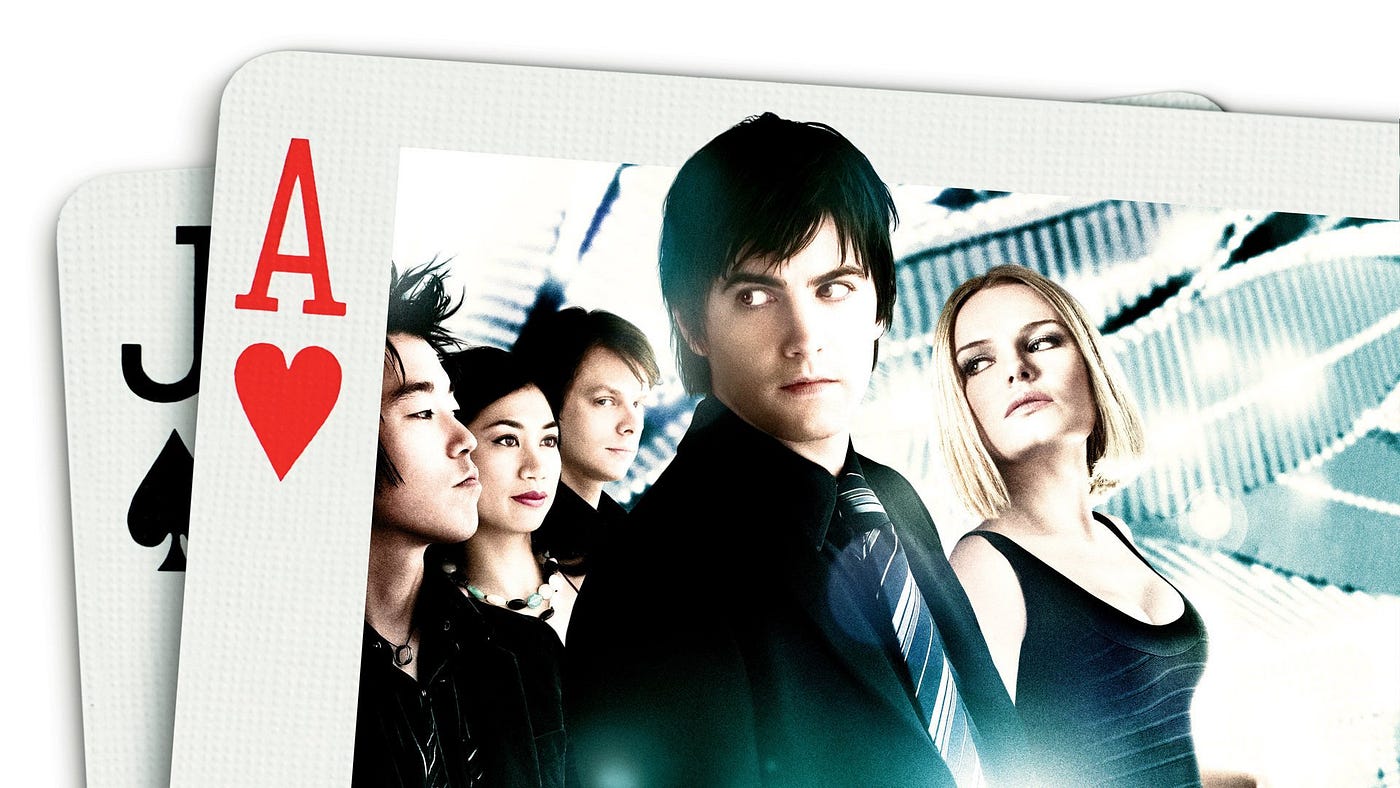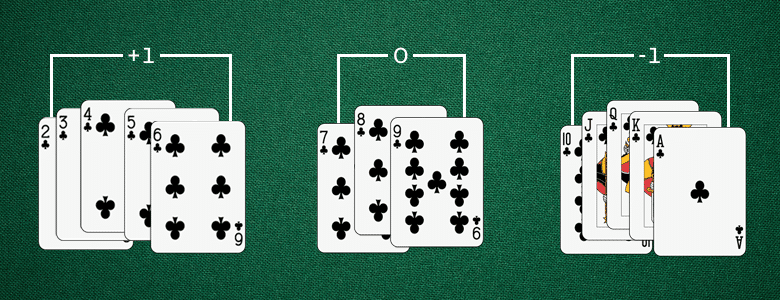How Does Knowing the Count Help You in Blackjack

Tips & Tricks
How To Count Cards
An Homage & Walk-Through Of The Infamous Hello-Lo System
A common cultural trope, as portrayed in Hollywood, for a financially-drastic mathematician, is to turn to some greyness-shade, barely legal activity that leverages their deep understanding of numbers. Most of the fourth dimension this entails some type of seemingly-impossible programming job aided by a noire tale of hackers & cyberpunk settings. Other times though, we meet our heroes commutation their pocket protectors for a decent push button-downwardly & slacks as they head downwardly to the bustling casino. A sea of dirty bright lights with the perpetual lingering smell of dried smoke, the casino is a place where numbers rule & the house always wins — it's the perfect cover for a seriously talented mathematician to, well, flip the business firm odds & force his or her luck. The nearly common vector of assault in casinos, as fabricated famous by both mainstream hits Pelting Man (1988) & 21 (2008), comes from one of the most-recognized games: Blackjack.
How Is It Played?
Blackjack is a game played against the dealer, non other players. To start, the dealer deals two cards to both the player & themselves; all cards except for one of the dealer's cards are face up (revealed). Each card is worth the number value fastened to it — 2 is worth 2, iii is worth 3, 4 is worth 4, etc. Face cards (J,Q,1000) are worth 10, & Aces are worth either one or 11 (dealers denote whether Aces are high (11) or low (1)). After the first two cards, each player has the pick to ask for another menu (to "striking") or not (to "stand up"). The objective of Blackjack is for the sum of the player's cards to be as close to 21 equally possible without going over 21. The player loses if either the cards add up to more than than 21 ("busting"), or if the sum of the dealer's cards is closer to 21.
But What About The House Edge?
It's not obvious, simply the house-edge creeps in from ii asymmetries. First, the dealer's hidden (aka "hole") menu — knowing this would complete the player's informational map (though the obvious argument here is that dealer as well doesn't know this card). The second asymmetry, notwithstanding, is where the border actually creeps-in: forcing the player to brand the first motility (hit or stand). Past hiding one card & forcing the player to determine with incomplete information, the histrion is susceptible to unnecessarily busting.
Nevertheless, There'due south An Boosted Principle To BlackJack That Quick Mathematicians Tin can Leverage To Increment Their Odds…
Blackjack games take a memory — they're played with a finite set of cards (one or many decks). Past knowing which cards were already dealt, it's possible to calculate which cards are to come up.
Decks in Blackjack do non completely reset later on each circular, which ways information technology possible to proceeds cognition of the cards in the shoe that remain. Additionally, the actions of the dealer are stock-still & known — they'll mechanically always hit anything below 17. With these two facts, we tin can build a strategy with a value system that designates cards to come up every bit either "bad" or "good."
Since a dealer will automatically striking below 17, regardless of the cards to come up, we'd like them to receive high cards (10 & face cards) in club to increase the probability of them busting. Given our original standing at the outset of the game (the value of the first 2 cards), if nosotros know whether the next carte is likely low or high, the decision to striking or stand is more straightforward.
In summary, there are certain "good cards" (high cards, such as aces & face cards) & certain "bad" cards that you don't want dealt (low cards, such as vi'south). This is how a strategy is synthetic using conditional probability. You want to bet higher if more bad cards have been removed (because more good cards remain), & bet lower if more skillful cards have been played already (because more than bad cards remain). This is the basis of how bill of fare counting works.
Crash Course To The Hi-Lo System
Card counting is a strategy synthetic on simple addition/subtraction & conditional probability to determine what kind of carte (hullogh or low — thus the name) is likely to be dealt next. In the Hi-Lo card-counting organization, each card has i of the iii following points: -1,0, & 1. As seen in the diagram below, cards 2–6 are worth +1, cards seven–9 are worth 0, and 10s, face cards, & Aces are worth -one:

The objective is to "keep the count" by adding up all of the cards that have been dealt using the signal organisation detailed to a higher place. So, for example, if a ten, 7, 3, & Q have been dealt, the indicate value (or "the count") would be (-one)+(0)+(+1)+(-1) = -1 (bet minimum). The mathematical theory is based on the sum of the cards that have passed, which clues us in on the cards that are left in the deck. In general, the higher the "count," the better for the player who should bet heavily; the lower the "count," the improve for the dealer, and then the actor should bet lightly or not at all.
The Underlying Mechanics
The Hi-Lo system works because it'south constructed on pure probability. The system itself is essentially a clever shortcut that circumvents the more-complex mental tasks involved with calculating percentages. For a comparative example, permit's consider that if instead of the system higher up, nosotros started with the more basic question: later the initial round of dealing in a single-handed game, what'due south the probability of the adjacent carte beingness a high-value card?
Permit's pretend the actor was dealt [3 spades, five hearts] & the dealer was dealt [four clubs, X]. In this game starting out with 52 cards, we now know the value of iii of them, which reduces the number of cards in the shoe by 3; in other words, we accept 49 cards remaining. Given that there are xx high cards per deck (4 suites * (ten,J,Q,K,A)), the probability of the next card dealt existence a high card is 20/49 (~xl%).
The math, while unproblematic, is significantly more than tasking withal provides arguably less data within the context of Blackjack. Tin can you I=imagine keeping track with basic probability in a vi-handed game? Impossible. A brilliant utilize of dimension-reducibility, the Hullo-Lo system consists of tracking a single "count" that'southward shifted past only adding -1,0, & one — magnitudes simpler.
That's It? That's All It Takes To Count Cards?!?
Believe it or not, that is indeed all the math required in the Hollywood-famed Hello-Lo card counting organisation. It'due south deceptively basic, still, most people are overlooking two additional points of complication that rear their head in the theory-to-implementation translation:
- Modernistic Blackjack is played with probable up to six-decks
- Blackjack is most never two-handed (only player vs. dealer)
Unsurprisingly, casinos like to guarantee a mathematical house border. Traditionally, Blackjack games were played with one or two decks maximum at a fourth dimension. Later a few decades of losing increasingly more money to menu-counters, casinos deployed a defence force machinery by playing through six, vii or eight decks at a time. This drastically increases the variance of the How-do-you-do-Lo system, which decreases its efficiency in the short-run. Additionally, it requires sitting through an unabridged play-through takes essentially longer, which, in turn, increases the likelihood of getting caught.
Side by side, the mental dexterity required in-field grows increasingly complicated when one considers that near games are multi-handed; keeping rails when information technology's single-handed (you & the dealer) doesn't seem too complicated, especially considering you lot command the flow of the game. Played with two, three or five people at a fourth dimension? All of a sudden it doesn't matter how simple the math is — speed & precision is the name of the game. Everyone can add by ane or subtract by one, but doing then in real-fourth dimension with a professional person dealer playing 6 easily is extremely mentally tasking. Surprisingly, this is where our able mathematicians derive their advantage; not from avant-garde calculus or some exotic Monte-Carlo formula, but rather in their rapid mental calculations. Card counting does not require complex math. It involves simple addition & subtraction; however, information technology does take someone who has a almost-eidetic memory, the ability to maintain focus nether enormous pressure, & is extremely fast at mental calculations.
This essay is part of a series of stories on math-related topics, published in Cantor's Paradise, a weekly Medium publication. Thank you for reading!
Source: https://www.cantorsparadise.com/how-to-count-cards-a2e75e14165e
Post a Comment for "How Does Knowing the Count Help You in Blackjack"